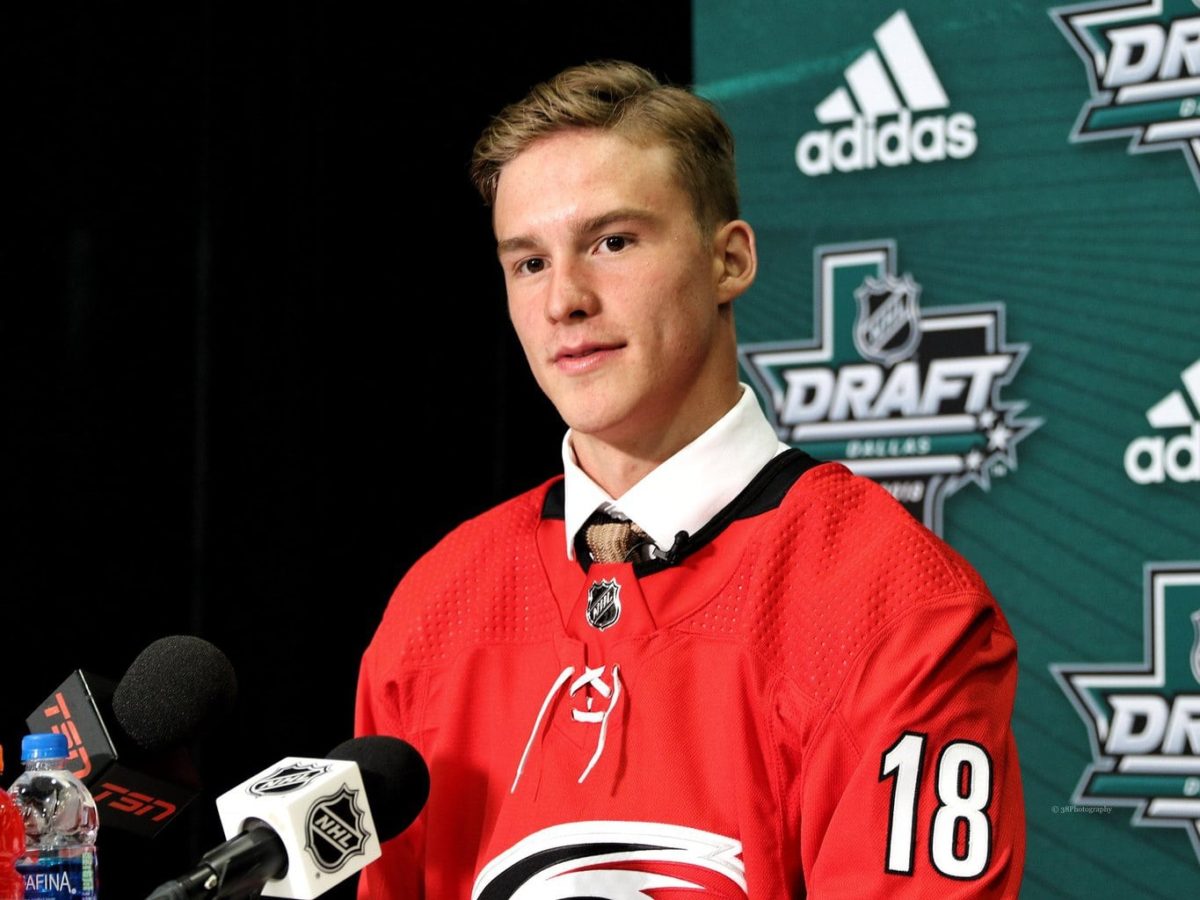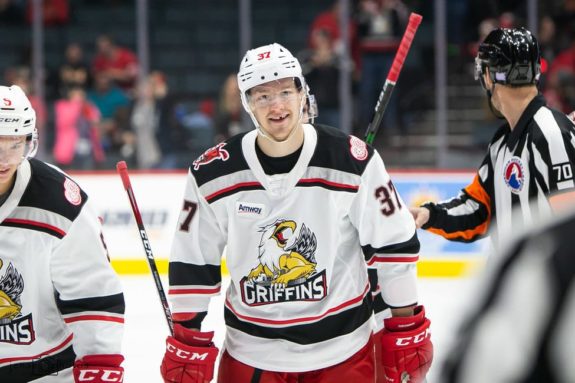It seems like so long ago, but there was a time when the Detroit Red Wings and its fanbase were very excited about Evgeny Svechnikov. He was a goofy Russian forward that had skill, a contagious smile and a love for chocolate milk and cookies. He and Dylan Larkin, drafted in the first round the year before, were the Red Wings’ top two prospects – a center and a winger that you could project as part of Detroit’s top six for the foreseeable future. The 19th selection of the 2015 draft had plenty to smile about, and we all smiled with him.
Since then, Svechnikov has seen just 20 games of NHL action – his most recent game was on October 27, 2019 where he played just over six minutes in an overtime loss to the St. Louis Blues. In the meantime, his younger brother Andrei became the second pick of the 2018 draft, and has gone on to record 114 points in 169 games. The younger Svechnikov is well on his way to becoming a superstar in the NHL – if he isn’t one already – and some even refer to the lacrosse-style goal as “The Svechnikov” in his honor. As happy as his older brother is to see his success, you’ve got to think that there’s perhaps a little bit of jealousy considering how vastly different their careers have gone up until this point.
To some extent, this is a story of bad luck at bad times. However, you could also consider this story a prime example of the faults with the “Red Wing Way”. How does a former first round selection go from a top prospect to a guy that passes through waivers unclaimed? Here’s how:
Injuries and Setbacks
Fair or not, Svechnikov’s professional career has been completely defined by his health. A well-documented knee surgery held him completely out of the 2018-19 season – the season he was set to really begin to challenge for a full-time spot with the Red Wings. Prior to the injury/surgery, he had performed well with the Grand Rapids Griffins, the Red Wings’ AHL-affiliate, where he had collected 74 points in 131 games. He also played a big part in the Griffins’ 2017 Calder Cup championship when he put up 12 points in 19 games. He got into 14 games with the Red Wings during the 2017-18 season, and he collected all of his four NHL points during that stint. His brother was drafted second overall in the late Spring of 2018, and that Fall was supposed to be the debut of both brothers in the NHL on a regular basis.

Missing an entire season is a huge setback for any athlete, let alone a young kid that hasn’t “earned his wings” in the NHL quite yet. With the ability to send Svechnikov down to the AHL without passing him through waivers, it made sense at the time to return him to the Griffins during the 2019-20 season in order to help him get his legs back. Regardless of how good he felt following his surgery, it would take a while before he started to look like the player that was on the verge of the NHL.
Naturally, Svechnikov did not perform as well as he had in years prior. In 51 games last season (cut short due to the ongoing pandemic), he had 25 points and struggled to find consistency. Throughout his AHL career up until this season, he had played in 182 regular season games (208 if you include playoffs) and notched 99 points (113 with playoffs added). Looking at the big picture, you can see that he has a scoring rate of .53 points per-game (P/G). In comparison, Filip Zadina, the Red Wings’ top pick in the 2018 draft, put up a P/G rate of .64, so while Svechnikov’s scoring rates don’t exactly scream “top six”, they do show that this forward still has the ability to create offense.
Too Much AHL Time?
The AHL, despite the quality competition you can observe throughout the league, is a developmental league. AHL veterans are often brought in to foster a more competitive team so that the team’s young players can play in big situations without their learning curves effecting the NHL team’s results. As of 2019, almost 88 percent of players in the NHL spent time in the AHL, so there’s no shame in spending time down in the lower league. But is there such a thing as too much time in the AHL? I would say yes.

Young players are sent to the AHL for a variety of reasons. They are sent there to work out flaws in their game, to get minutes while the NHL roster is full and to learn the pro-game at a lower level. That’s fine and dandy – every team does this.
The Red Wings, however, do things slightly differently than most teams. The “Red Wing Way” has been to keep young players in the lower leagues until they are “over-ripe” and clearly ready for higher competition. They have been doing this since Ken Holland was the general manager, and it appears that new GM Steve Yzerman subscribes to this line of thinking as well. Sometimes it drives fans nuts, but more often than not, a player will show that they are ready for the NHL under these circumstances. For example, despite a strong training camp prior to the start of the 2016-17 season, winger Anthony Mantha was sent to the AHL. However, after looking dominant over the first 10 games of the Griffins’ season, the Red Wings called him up, and he has been in the NHL ever since.
In regards to Svechnikov, at 24 years old, he isn’t a player that needs to “learn the game”. The quirks in his game aren’t going to make any progress unless he can face stiffer competition; if you’re trying to develop an NHL player, at some point they have to face NHL players on a regular basis for the good of their development. In fact, the only reason for keeping him in the AHL is so that he can get regular playing time while the Red Wings’ roster is filled up.
However, that’s not where Svechnikov finds himself right now.
The Taxi Squad?
On February 16, the Red Wings announced the following move:
In the five games since then, Svechnikov has sat idle on the taxi squad. While with the taxi squad, the forward has been able to practice with the rest of the Red Wings’ roster, but practicing is not equivalent to game action. If there’s one player in the Red Wings’ organization that needs playing time right now, it’s Svechnikov. Putting him in a position where he doesn’t get those minutes is a disservice to him, and it’s poor asset management.
Not to mention the fact that it goes against everything we’ve heard up until this point about why certain players are sent to Grand Rapids instead of staying in Detroit. When forward Michael Rasmussen was sent to the AHL earlier this month, despite a strong showing with the Red Wings, head coach Jeff Blashill pointed to playing time and confidence as the key reasons why the team sent him down to the AHL. Alright, fine, but what about Svechnikov? He isn’t getting playing time on the taxi squad, and that certainly isn’t a way to boost his confidence.
All of that being said, there may be light at the end of the tunnel:
Should Svechnikov see action during this weekend’s series against the Chicago Blackhawks, it would mark his first taste of NHL action in well over a year, so it would be best to temper expectations. Of course, once he gets his feet wet, you have to hope that he can have a positive influence on the Red Wings, probably in a third line role.
Should He Stay or Should He Go?
Everyone wants to see the Red Wings get younger as veterans are shipped out and the team’s prospects seize those opportunities. While Svechnikov hardly passes as a prospect at this point, he is the kind of young talent that the team needs to take a step forward if they want to veer younger as a group. In order for him to take that step, he needs an opportunity – a real, honest opportunity that showcases his strengths. Playing him on the fourth line or not playing him at all will do nothing for him.
What’s the worst that can happen? If Svechnikov gets an opportunity and can’t do anything with it, then you know it’s time to move on – at least the team can say they gave him a shot. If he does show some promise, however, the Red Wings gain options that they didn’t necessarily have before. They can keep him in their lineup and use him as a cheap source of offense, or they can build him up and then deal him away for another future asset. Long story short, they give themselves zero options if they don’t give this kid a chance, and it’s never wise to leave yourself without options.
At the core of this issue, though, is a young forward who just wants to realize his dream of becoming a legitimate NHL player. While fate hasn’t been kind to him, neither has the team that drafted him. If this team is serious about turning the team over to younger players, then at some point they have to actually do it. Svechnikov is hungry for an opportunity, and he’s at the point in his career where a lack of one could be the death blow for his career. It’s up to the Red Wings to finally give him a shot.
But then, as it always is, it’s up to the player to make good on that opportunity.
Want more Red Wings content? Tune into The Hockey Writers’ Grind Line — a weekly show on YouTube and Facebook. We stream Friday nights starting at 8:00 P.M. ET on The Hockey Writers YouTube channel. Check out our most recent show below, and make sure you subscribe to the channel so you don’t miss any upcoming shows.